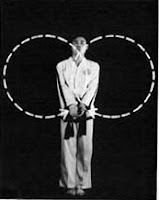Kwang-Gae, better romanized Gwang-Gae, is one of the three 1st Dan patterns. It is named after Great King Gwang-Gae To
광개토태왕. The ITF Encyclopaedia describes the meaning of the pattern as follows:
KWANG-GAE is named after the famous Kwang-Gae-Toh-Wang, the 19th King of the Koguryo Dynasty, who regained all the lost territories including the greater part of Manchuria. The diagram represents the expansion and recovery of lost territory. The 39 movements refer to the first two figures of 391 A. D, the year he came to the throne.
Although the number of movements refer to the year he came to the thrown, it could also possibly refer to his death. He died at age 39. He was 17 when he became king and reigned for 22 years.
There are only two Korean kings called "Great King," they are Great King Gwang-Gae To and Great King Sejong, the latter commissioned the Korean alphabet, Hangeul, which brought literacy to the masses.
Gwang-Gae To
廣開土 is his
posthumous name. Its meaning has to do with expansion of territory. Based on the Chinese (Hanja) characters, the first syllable (
廣) in his posthumous name means broad or wide. The second character (
開) means to open something or to start something (e.g. start a project). Finally, the last character (
土) refers to soil or earth. During his life time Great King Gwang-Gae To was known as King Yeong-Nak (영낙) the Great. Since I couldn't find the Chinese characters in which his
renal name is based, I cannot look up the meaning of it. His birth name was Go Damdeok (Korean: 고담덕 / Hanja:
高談德). His family name, Go, means high or lofty and is the same first syllable in Goguryeo, the ancient Korean kingdom he inherited and expanded. His name Dam-deok literally means "talk-virtue." Personally I like his birth name better as it reflects the virtuous or ethical nature of Great King Gwang-Gae's governance. Even though he regained lost territory and expanded the Goguryeo borders deep into Manchuria, he did not force his personal culture onto the many different tribes and people that came under his reign -- he allowed them to "maintain [their] own lifestyle, customs, religion and values" (
Yun Myeon-Cheol).
 |
| "The Gwang Gae To Steel" Source |
Much of what we know about Great King Gwang-Gae To comes from the Gwang-Gae To Stele, a giant stone inscribed with classical Chinese characters. The a stele is a granite obelisk, about seven meters tall. It was erected by Gwang-Gae To's son, King Jangsu. The stele is on the border of China and North Korea. There is a copy of the stele at the South Korea's National War Museum in Seoul.
Read more about Great King Gwang-Gae To.
The pattern is quite interesting. It has a very unique feel about it. Many of the movements are performed in slow motion. There are also many motions that move in wide elliptical paths. For instance, the first movement, the Heaven Hand to Close Ready Stance B position, traces an elliptical path in the air.
To me it looks like the motions symbolize both gathering (regaining lost territory) and expansion. The slow motions may refer to his patient and strategic character, followed by strong decisive techniques, like the various stomping motions in the pattern, depicting his effective military action. Kwang-Gae Teul is definitely a pattern that requires careful study. It is one of the patterns that reflects the hard-soft nature of ITF Taekwon-Do excellently.












